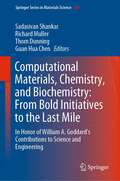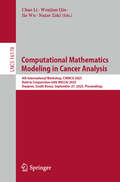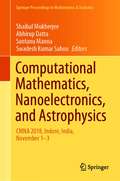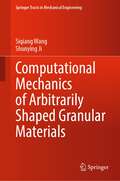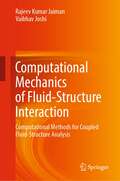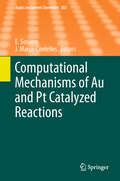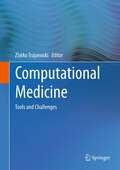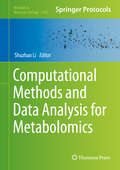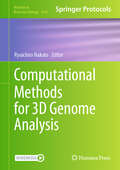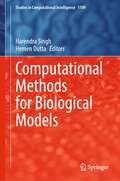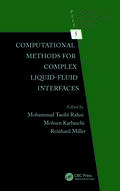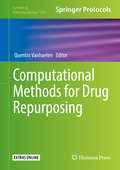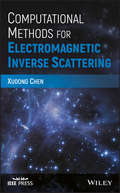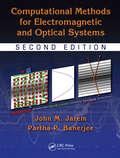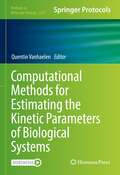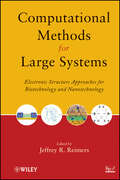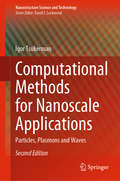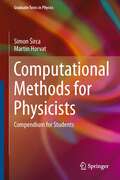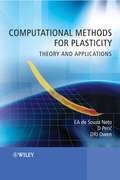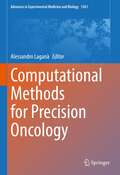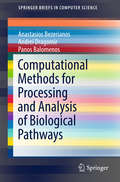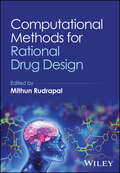- Table View
- List View
Computational Materials, Chemistry, and Biochemistry: In Honor of William A. Goddard’s Contributions to Science and Engineering (Springer Series in Materials Science #284)
by Richard Muller Thom Dunning Sadasivan Shankar Guan Hua ChenThis book provides a broad and nuanced overview of the achievements and legacy of Professor William (“Bill”) Goddard in the field of computational materials and molecular science. Leading researchers from around the globe discuss Goddard’s work and its lasting impacts, which can be seen in today’s cutting-edge chemistry, materials science, and biology techniques. Each section of the book closes with an outline of the prospects for future developments.In the course of a career spanning more than 50 years, Goddard’s seminal work has led to dramatic advances in a diverse range of science and engineering fields. Presenting scientific essays and reflections by students, postdoctoral associates, collaborators and colleagues, the book describes the contributions of one of the world’s greatest materials and molecular scientists in the context of theory, experimentation, and applications, and examines his legacy in each area, from conceptualization (the first mile) to developments and extensions aimed at applications, and lastly to de novo design (the last mile). Goddard’s passion for science, his insights, and his ability to actively engage with his collaborators in bold initiatives is a model for us all. As he enters his second half-century of scientific research and education, this book inspires future generations of students and researchers to employ and extend these powerful techniques and insights to tackle today’s critical problems in biology, chemistry, and materials. Examples highlighted in the book include new materials for photocatalysts to convert water and CO2 into fuels, novel catalysts for the highly selective and active catalysis of alkanes to valuable organics, simulating the chemistry in film growth to develop two-dimensional functional films, and predicting ligand–protein binding and activation to enable the design of targeted drugs with minimal side effects.
Computational Mathematics Modeling in Cancer Analysis: 4th International Workshop, CMMCA 2025, Held in Conjunction with MICCAI 2025, Daejeon, South Korea, September 27, 2025, Proceedings (Lecture Notes in Computer Science #16178)
by Chao Li Jia Wu Nazar Zaki Wenjian QinThis book constitutes the refereed proceedings of the 4th International Workshop on Computational Mathematics Modeling in Cancer Analysis, CMMCA 2025, held in Daejeon, South Korea, during September 27, 2025, in conjunction with MICCAI 2025. The 17 full papers presented in this book were carefully reviewed and selected from 24 submissions. These papers focus on algorithmic and mathematical innovations that advance cancer imaging and analysis across spatial, temporal, and biological scales.
Computational Mathematics, Nanoelectronics, and Astrophysics: CMNA 2018, Indore, India, November 1–3 (Springer Proceedings in Mathematics & Statistics #342)
by Abhirup Datta Santanu Manna Shaibal Mukherjee Swadesh Kumar SahooThis book is a collection of original papers presented at the International Conference on Computational Mathematics in Nanoelectronics and Astrophysics (CMNA 2018) held at the Indian Institute of Technology Indore, India, from 1 to 3 November 2018. It aims at presenting recent developments of computational mathematics in nanoelectronics, astrophysics and related areas of space sciences and engineering. These proceedings discuss the most advanced innovations, trends and real-world challenges encountered and their solutions with the application of computational mathematics in nanoelectronics, astrophysics and space sciences. From focusing on nano-enhanced smart technological developments to the research contributions of premier institutes in India and abroad on ISRO’s future space explorations—this book includes topics from highly interdisciplinary areas of research. The book is of interest to researchers, students and practising engineers working in diverse areas of science and engineering, ranging from applied and computational mathematics to nanoelectronics, nanofabrications and astrophysics.
Computational Mechanics of Arbitrarily Shaped Granular Materials (Springer Tracts in Mechanical Engineering)
by Shunying Ji Siqiang WangThis book focuses on discrete element methods for arbitrarily shaped granular materials, including super-quadric models, spherical harmonic functions and level set methods, and numerical analysis of the flow characteristics of non-spherical granular materials. This book is used as a reference book for scientific researchers engaged in dynamic analysis of granular materials and optimal design of equipment structures in the fields of engineering mechanics, applied physics, mechanical engineering, and chemical engineering, as well as for graduate students or senior undergraduates of related majors in institutions of higher education.
Computational Mechanics of Fluid-Structure Interaction: Computational Methods for Coupled Fluid-Structure Analysis
by Rajeev Kumar Jaiman Vaibhav JoshiThis book is intended to provide a compilation of the state-of-the-art numerical methods for nonlinear fluid-structure interaction using the moving boundary Lagrangian-Eulerian formulation. Single and two-phase viscous incompressible fluid flows are considered with the increasing complexity of structures ranging from rigid-body, linear elastic and nonlinear large deformation to fully-coupled flexible multibody system. This book is unique with regard to computational modeling of such complex fluid-structure interaction problems at high Reynolds numbers, whereby various coupling techniques are introduced and systematically discussed. The techniques are demonstrated for large-scale practical problems in aerospace and marine/offshore engineering. This book also provides a comprehensive understanding of underlying unsteady physics and coupled mechanical aspects of the fluid-structure interaction from a computational point of view. Using the body-fitted and moving mesh formulations, the physical insights associated with structure-to-fluid mass ratios (i.e., added mass effects), Reynolds number, large structural deformation, free surface, and other interacting physical fields are covered. The book includes the basic tools necessary to build the concepts required for modeling such coupled fluid-structure interaction problems, thus exposing the reader to advanced topics of multiphysics and multiscale phenomena.
Computational Mechanics with Neural Networks (Lecture Notes on Numerical Methods in Engineering and Sciences)
by Genki Yagawa Atsuya OishiThis book shows how neural networks are applied to computational mechanics. Part I presents the fundamentals of neural networks and other machine learning method in computational mechanics. Part II highlights the applications of neural networks to a variety of problems of computational mechanics. The final chapter gives perspectives to the applications of the deep learning to computational mechanics.
Computational Mechanisms of Au and Pt Catalyzed Reactions (Topics in Current Chemistry #302)
by José Marco-Contelles Elena SorianoStructure, Bonding, and Reactivity of Reactant Complexes and Key Intermediates, by Elena Soriano and José Marco-Contelles.- Cycloisomerization of 1,n-Enynes Via Carbophilic Activation, by Patrick Yves Toullec and Véronique Michelet.- DFT-Based Mechanistic Insights into Noble Metal-Catalyzed Rearrangement of Propargylic Derivatives: Chirality Transfer Processes, by Olalla Nieto Faza and Angel R. de Lera.- N-Heterocyclic Carbene Complexes of Au, Pd, and Pt as Effective Catalysts in Organic Synthesis, by Andrea Correa, Steven P. Nolan and Luigi Cavallo.- Activation of Allenes by Gold Complexes: A Theoretical Standpoint, by Max Malacria, Louis Fensterbank and Vincent Gandon.- Heterocyclization of Allenes Catalyzed by Late Transition Metals: Mechanisms and Regioselectivity, by Benito Alcaide, Pedro Almendros, Teresa Martínez del Campo, Elena Soriano and José Marco-Contelles.- Gold-Catalyzed Cycloadditions Involving Allenes: Mechanistic Insights from Theoretical Studies, by Sergi Montserrat, Gregori Ujaque, Fernando López, José L. Mascareñas and Agustí Lledós.-
Computational Medicine: Tools and Challenges
by Zlatko TrajanoskiComputational methodologies and modeling play a growing role for investigating mechanisms, and for the diagnosis and therapy of human diseases. This progress gave rise to computational medicine, an interdisciplinary field at the interface of computer science and medicine. The main focus of computational medicine lies in the development of data analysis methods and mathematical modeling as well as computational simulation techniques specifically addressing medical problems. In this book, we present a number of computational medicine topics at several scales: from molecules to cells, organs, and organisms. At the molecular level, tools for the analysis of genome variations as well as cloud computing resources for medical genetics are reviewed. Then, an analysis of gene expression data and the application to the characterization of microbial communities are highlighted. At the protein level, two types of analyses for mass spectrometry data are reviewed: labeled quantitative proteomics and lipidomics, followed by protein sequence analysis and a 3D structure and drug design chapter. Finally, three chapters on clinical applications focus on the integration of biomolecular and clinical data for cancer research, biomarker discovery, and network-based methods for computational diagnostics.
Computational Methods and Data Analysis for Metabolomics (Methods in Molecular Biology #2104)
by Shuzhao LiThis book provides a comprehensive guide to scientists, engineers, and students that employ metabolomics in their work, with an emphasis on the understanding and interpretation of the data. Chapters guide readers through common tools for data processing, using database resources, major techniques in data analysis, and integration with other data types and specific scientific domains. Written in the highly successful Methods in Molecular Biology series format, chapters include introductions to their respective topics, practical guidance of methods and techniques, useful web supplements, and connect the steps from experimental metabolomics to scientific discoveries. Authoritative and cutting-edge, Computational Methods and Data Analysis for Metabolomics to ensure successful results in the further study of this vital field.
Computational Methods for 3D Genome Analysis (Methods in Molecular Biology #2856)
by Ryuichiro NakatoThis volume covers the latest methods and analytical approaches used to study the computational analysis of three-dimensional (3D) genome structure. The chapters in this book are organized into six parts. Part One discusses different NGS assays and the regulatory mechanism of 3D genome folding by SMC complexes. Part Two presents analysis workflows for Hi-C and Micro-C in different species, including human, mouse, medaka, yeast, and prokaryotes. Part Three covers methods for chromatin loop detection, sub-compartment detection, and 3D feature visualization. Part Four explores single-cell Hi-C and the cell-to-cell variability of the dynamic 3D structure. Parts Five talks about the analysis of polymer modelling to simulate the dynamic behavior of the 3D genome structure, and Part Six looks at 3D structure analysis using other omics data, including prediction of 3D genome structure from the epigenome, double-strand break-associated structure, and imaging-based 3D analysis using seqFISH. Written in the highly successful Methods in Molecular Biology series format, chapters include introductions to their respective topics, lists of the necessary materials and tools, step-by-step, readily reproducible laboratory protocols, and tips on troubleshooting and avoiding known pitfalls. Cutting-edge and thorough, Computational Methods for 3D Genome Analysis: Methods and Protocols is a valuable resource for researchers interested in using computational methods to further their studies in the nature of 3D genome organization.
Computational Methods for Biological Models (Studies in Computational Intelligence #1109)
by Hemen Dutta Harendra SinghThis book discusses computational methods related to biological models using mathematical tools and techniques. The book chapters concentrate on numerical and analytical techniques that provide a global solution for biological models while keeping long-term benefits in mind. The solutions are useful in closely understanding biological models, and the results will be very useful for mathematicians, engineers, doctors, scientists and researchers working on real-life biological models. This book provides significant and current knowledge of biological models related to real-life applications. The book covers both methods and applications.
Computational Methods for Complex Liquid-Fluid Interfaces (Progress in Colloid and Interface Science)
by Reinhard Miller Mohsen Karbaschi Mohammad Taeibi RahniComputational Methods for Complex Liquid-Fluid Interfaces highlights key computational challenges involved in the two-way coupling of complex liquid-fluid interfaces. The book covers a variety of cutting-edge experimental and computational techniques ranging from macro- to meso- and microscale approaches (including pivotal applications). As example
Computational Methods for Drug Repurposing (Methods in Molecular Biology #1903)
by Quentin VanhaelenThis detailed book explores techniques commonly used for research into drug repurposing, a well-known strategy to find alternative indications for drugs which have already undergone toxicology and pharma-kinetic studies but have failed later stages during the development, via computational methods. Thereby, it addresses the intense challenges of identifying the appropriate type of algorithm and relevant technical information for computational repurposing. Written for the highly successful Methods in Molecular Biology series, the authors of each chapter use their experience in the field to describe the implementation and successful use of a specific repurposing method thus providing lab-ready instruction. Authoritative and practical, Computational Methods for Drug Repurposing serves as an ideal guide to researchers interested in this vital area of drug development.
Computational Methods for Electromagnetic Inverse Scattering (Wiley - IEEE)
by Xudong ChenA comprehensive and updated overview of the theory, algorithms and applications of for electromagnetic inverse scattering problems Offers the recent and most important advances in inverse scattering grounded in fundamental theory, algorithms and practical engineering applications Covers the latest, most relevant inverse scattering techniques like signal subspace methods, time reversal, linear sampling, qualitative methods, compressive sensing, and noniterative methods Emphasizes theory, mathematical derivation and physical insights of various inverse scattering problems Written by a leading expert in the field
Computational Methods for Electromagnetic Phenomena: Electrostatics in Solvation, Scattering, and Electron Transport
by Wei CaiA unique and comprehensive graduate text and reference on numerical methods for electromagnetic phenomena, from atomistic to continuum scales, in biology, optical-to-micro waves, photonics, nanoelectronics and plasmas. The state-of-the-art numerical methods described include: • Statistical fluctuation formulae for the dielectric constant • Particle-Mesh-Ewald, Fast-Multipole-Method and image-based reaction field method for long-range interactions • High-order singular/hypersingular (Nyström collocation/Galerkin) boundary and volume integral methods in layered media for Poisson-Boltzmann electrostatics, electromagnetic wave scattering and electron density waves in quantum dots • Absorbing and UPML boundary conditions • High-order hierarchical Nédélec edge elements • High-order discontinuous Galerkin (DG) and Yee finite difference time-domain methods • Finite element and plane wave frequency-domain methods for periodic structures • Generalized DG beam propagation method for optical waveguides • NEGF(Non-equilibrium Green's function) and Wigner kinetic methods for quantum transport • High-order WENO and Godunov and central schemes for hydrodynamic transport • Vlasov-Fokker-Planck and PIC and constrained MHD transport in plasmas
Computational Methods for Electromagnetic and Optical Systems (Optical Science and Engineering)
by John M. Jarem Partha P. BanerjeeThe current rapid and complex advancement applications of electromagnetic (EM) and optical systems calls for a much needed update on the computational methods currently in use. Completely revised and reflecting ten years of develoments, this second edition of the bestselling Computational Methods for Electromagnetic and Optical Systems provides the
Computational Methods for Estimating the Kinetic Parameters of Biological Systems (Methods in Molecular Biology #2385)
by Quentin VanhaelenThis detailed book provides an overview of various classes of computational techniques, including machine learning techniques, commonly used for evaluating kinetic parameters of biological systems. Focusing on three distinct situations, the volume covers the prediction of the kinetics of enzymatic reactions, the prediction of the kinetics of protein-protein or protein-ligand interactions (binding rates, dissociation rates, binding affinities), and the prediction of relatively large set of kinetic rates of reactions usually found in quantitative models of large biological networks. Written for the highly successful Methods in Molecular Biology series, chapters include the kind of expert implementation advice that leads to successful results. Authoritative and practical, Computational Methods for Estimating the Kinetic Parameters of Biological Systems will be of great interest for researchers working through the challenge of identifying the best type of algorithm and who would like to use or develop a computational method for the estimation of kinetic parameters.
Computational Methods for Large Systems: Electronic Structure Approaches for Biotechnology and Nanotechnology
by Jeffrey R. ReimersWhile its results normally complement the information obtained by chemical experiments, computer computations can in some cases predict unobserved chemical phenomena Electronic-Structure Computational Methods for Large Systems gives readers a simple description of modern electronic-structure techniques. It shows what techniques are pertinent for particular problems in biotechnology and nanotechnology and provides a balanced treatment of topics that teach strengths and weaknesses, appropriate and inappropriate methods. It’s a book that will enhance the your calculating confidence and improve your ability to predict new effects and solve new problems.
Computational Methods for Microstructure-Property Relationships
by Dennis Dimiduk Somnath GhoshComputational Methods for Microstructure-Property Relationships introduces state-of-the-art advances in computational modeling approaches for materials structure-property relations. Written with an approach that recognizes the necessity of the engineering computational mechanics framework, this volume provides balanced treatment of heterogeneous materials structures within the microstructural and component scales. Encompassing both computational mechanics and computational materials science disciplines, this volume offers an analysis of the current techniques and selected topics important to industry researchers, such as deformation, creep and fatigue of primarily metallic materials. Researchers, engineers and professionals involved with predicting performance and failure of materials will find Computational Methods for Microstructure-Property Relationships a valuable reference.
Computational Methods for Nanoscale Applications: Particles, Plasmons and Waves (Nanostructure Science and Technology)
by Igor TsukermanPositioning itself at the common boundaries of several disciplines, this work provides new perspectives on modern nanoscale problems where fundamental science meets technology and computer modeling. In addition to well-known computational techniques such as finite-difference schemes and Ewald summation, the book presents a new finite-difference calculus of Flexible Local Approximation Methods (FLAME) that qualitatively improves the numerical accuracy in a variety of problems.
Computational Methods for Physicists: Compendium for Students (Graduate Texts in Physics)
by Simon Sirca Martin HorvatThis book helps advanced undergraduate, graduate and postdoctoral students in their daily work by offering them a compendium of numerical methods. The choice of methods pays significant attention to error estimates, stability and convergence issues as well as to the ways to optimize program execution speeds. Many examples are given throughout the chapters, and each chapter is followed by at least a handful of more comprehensive problems which may be dealt with, for example, on a weekly basis in a one- or two-semester course. In these end-of-chapter problems the physics background is pronounced, and the main text preceding them is intended as an introduction or as a later reference. Less stress is given to the explanation of individual algorithms. It is tried to induce in the reader an own independent thinking and a certain amount of scepticism and scrutiny instead of blindly following readily available commercial tools.
Computational Methods for Plasticity
by D. Peric E. A. de Souza Neto D. R. OwenThe subject of computational plasticity encapsulates the numerical methods used for the finite element simulation of the behaviour of a wide range of engineering materials considered to be plastic - i.e. those that undergo a permanent change of shape in response to an applied force. Computational Methods for Plasticity: Theory and Applications describes the theory of the associated numerical methods for the simulation of a wide range of plastic engineering materials; from the simplest infinitesimal plasticity theory to more complex damage mechanics and finite strain crystal plasticity models. It is split into three parts - basic concepts, small strains and large strains. Beginning with elementary theory and progressing to advanced, complex theory and computer implementation, it is suitable for use at both introductory and advanced levels. The book:Offers a self-contained text that allows the reader to learn computational plasticity theory and its implementation from one volume.Includes many numerical examples that illustrate the application of the methodologies described.Provides introductory material on related disciplines and procedures such as tensor analysis, continuum mechanics and finite elements for non-linear solid mechanics.Is accompanied by purpose-developed finite element software that illustrates many of the techniques discussed in the text, downloadable from the book's companion website.This comprehensive text will appeal to postgraduate and graduate students of civil, mechanical, aerospace and materials engineering as well as applied mathematics and courses with computational mechanics components. It will also be of interest to research engineers, scientists and software developers working in the field of computational solid mechanics.
Computational Methods for Precision Oncology (Advances in Experimental Medicine and Biology #1361)
by Alessandro LaganàPrecision medicine holds great promise for the treatment of cancer and represents a unique opportunity for accelerated development and application of novel and repurposed therapeutic approaches. Current studies and clinical trials demonstrate the benefits of genomic profiling for patients whose cancer is driven by specific, targetable alterations. However, precision oncologists continue to be challenged by the widespread heterogeneity of cancer genomes and drug responses in designing personalized treatments. Chapters provide a comprehensive overview of the computational approaches, methods, and tools that enable precision oncology, as well as related biological concepts. Covered topics include genome sequencing, the architecture of a precision oncology workflow, and introduces cutting-edge research topics in the field of precision oncology. This book is intended for computational biologists, bioinformaticians, biostatisticians and computational pathologists working in precision oncology and related fields, including cancer genomics, systems biology, and immuno-oncology.
Computational Methods for Processing and Analysis of Biological Pathways (SpringerBriefs in Computer Science)
by Anastasios Bezerianos Andrei Dragomir Panos BalomenosThis work offers a guided walkthrough of one of the most promising research areas in modern life sciences, enabling a deeper understanding of involved concepts and methodologies via an interdisciplinary view, focusing on both well-established approaches and cutting-edge research. Highlighting what pathway analysis can offer to both the experimentalist and the modeler, the text opens with an introduction to a general methodology that outlines common workflows shared by several methods. This is followed by a review of pathway and sub-pathway based approaches for systems pharmacology. The work then presents an overview of pathway analysis methods developed to model the temporal aspects of drug- or disease-induced perturbations and extract relevant dynamic themes. The text concludes by discussing several state-of-the-art methods in pathway analysis, which address the important problem of identifying differentially expressed pathways and sub-pathways.
Computational Methods for Rational Drug Design
by Mithun RudrapalComprehensive resource covering computational tools and techniques for the development of cost-effective drugs to combat diseases, with specific disease examples Computational Methods for Rational Drug Design covers the tools and techniques of drug design with applications to the discovery of small molecule-based therapeutics, detailing methodologies and practical applications and addressing the challenges of techniques like AI/ML and drug design for unknown receptor structures. Divided into 23 chapters, the contributors address various cutting-edge areas of therapeutic importance such as neurodegenerative disorders, cancer, multi-drug resistant bacterial infections, inflammatory diseases, and viral infections. Edited by a highly qualified academic with significant research contributions to the field, Computational Methods for Rational Drug Design explores topics including: Computer-assisted methods and tools for structure- and ligand-based drug design, virtual screening and lead discovery, and ADMET and physicochemical assessmentsIn silico and pharmacophore modeling, fragment-based design, de novo drug design and scaffold hopping, network-based methods and drug discoveryRational design of natural products, peptides, enzyme inhibitors, drugs for neurodegenerative disorders, anti-inflammatory therapeutics, antibacterials for multi-drug resistant infections, and antiviral and anticancer therapeuticsProtac and protide strategies in drug design, intrinsically disordered proteins (IDPs) in drug discovery and lung cancer treatment through ALK receptor-targeted drug metabolism and pharmacokinetics Helping readers seamlessly navigate the challenges of drug design, Computational Methods for Rational Drug Design is an essential reference for pharmaceutical and medicinal chemists, biochemists, pharmacologists, and phytochemists, along with molecular modeling and computational drug discovery professionals.
